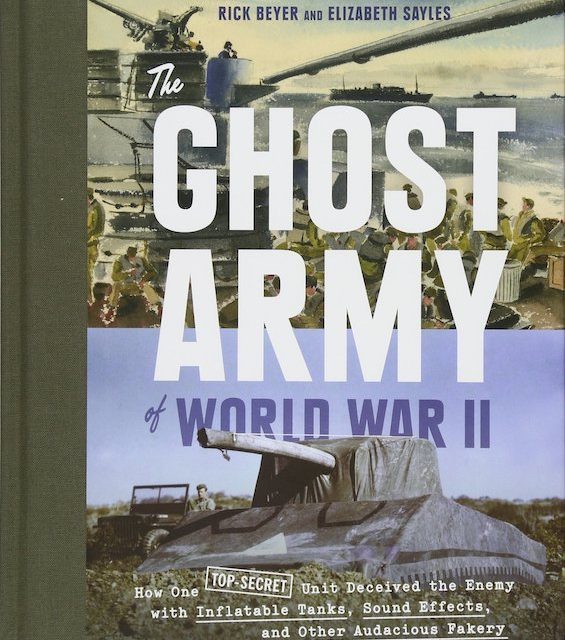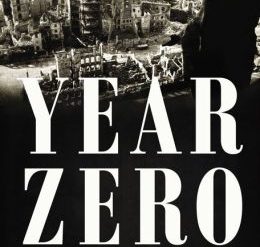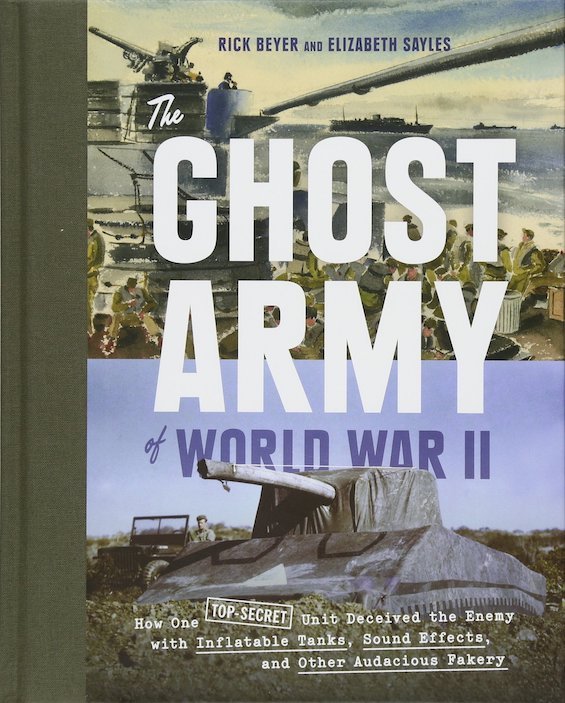
Estimated reading time: 8 minutes
A headline in a New York Times obituary recently caught my eye. “Gilbert Seltzer, Soldier in Secret Unit That Duped Germans, Is Dead at 106,” it read. In scanning the amazing story of Lieutenant Seltzer’s World War II experience, I came across a reference to a book about the top-secret unit in which he had served. That led me to The Ghost Army of World War II by Rick Beyer and Elizabeth Sayles. Their story, which is profusely illustrated, is one of the most astonishing tales of deception inWorld War II. It’s also immensely entertaining.
A beautifully illustrated story
This book is the outcome of Rick Beyer’s award-winning 2013 PBS documentary, The Ghost Army. Like the television production, the book version is a strongly visual presentation. Interspersed among the text and in “galleries” spaced between some chapters are images of hundreds of photos, sketches, and paintings. The graphics represent the work of some of the many artists of the Twenty-Third Headquarters Special Troops, the 1,100-man unit known as the Ghost Army. And I surmise that Beyer’s coauthor, artist Liz Sayles, is responsible for selecting the illustrations.
The Ghost Army of World War II: How One Top-Secret Unit Deceived the Enemy with Inflatable Tanks, Sound Effects, and Other Audacious Fakery by Rick Beyer and Elizabeth Sayles (2015) 257 pages ★★★★★
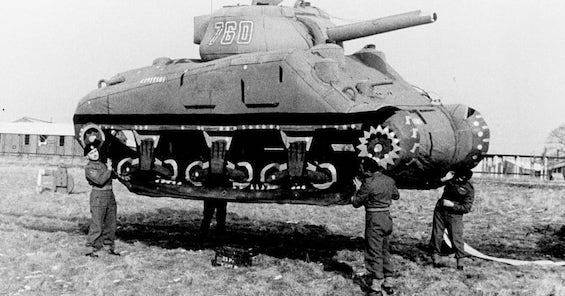
A battalion-size unit masquerading as two divisions
The Ghost Army was “capable of impersonating one or two infantry or armored divisions—the equivalent of twenty to forty times their number.” The unit represented one of the Allies’ most audacious efforts to use deception in the war against Nazi Germany. It was, the authors write, “the first unit in the history of warfare that was dedicated solely to deception.” The detachment operated for nine months in France, Luxembourg, and Germany, from the Normandy Invasion in June 1944 until V-E Day in May 1945. “Their mission was to put on a show, with the German Army as the audience. . . They pulled off twenty-one different deceptions and are credited with saving thousands of lives through stagecraft and sleight of hand.”
Artists, radio engineers, telegraph operators, and combat engineers
The Ghost Army’s 1,100 men were divided into four companies of somewhat unequal size.
- The Signal Company Special created torrents of false radio traffic to create the impression that one or two combat divisions had moved onto the line. The real divisions were deployed elsewhere and managed to surprise, or at least confuse, the Germans.
- The 3132 Signal Service Company Special played sound-effect records “from powerful speakers mounted on half-tracks . . . to simulate the sounds of units moving and operating at night.”
- The largest unit in the Ghost Army was the 603rd Engineer Camouflage Battalion Special. It was composed of artists and designers, including a number (such as Bill Blass and Ellsworth Kelly) who became famous in their fields following the war. They led “battalions of rubber dummies” of tanks, half-tracks, and airplanes to fool the Germans’ air reconnaissance. From time to time, officers in the company impersonated generals and swaggered through nearby towns in Jeeps bearing false insignia to ensure that collaborationists would get the word to the Nazis. (They did.)
- The 406th Engineer Combat Company Special consisted of 168 men “trained as fighting soldiers. They provided perimeter security for the rest of the Ghost Army . . . [and] frequently used their bulldozers to simulate tank tracks as part of the visual deception.”
Ironically, the old-hat Army colonel who commanded the unit didn’t believe in its mission. He tried to have the unit disbanded, so he could be reassigned to command a fighting regiment. But other officers, including his deputy, were supportive, and they worked around the old man’s resistance to novelty.
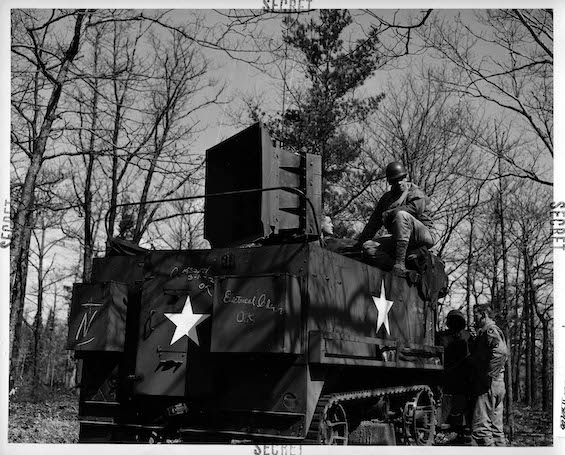
A tale told through the lives of the soldiers
Beyer and Sayles spin out their story in the words and images of the men of the Ghost Army. Dozens are cited by name in the book, some as the creators of the sketches, paintings, and photographs littered through the book, others in their reminiscences. Much of the authors’ account rests on the experience of the artists in the Camouflage Battalion—most likely, I imagine, because coauthor Liz Sayles had special access to them. Her grandfather was one of the artists in the unit, and she herself is an artist with many connections within her craft.
Deception in World War II
Both the Nazis and the Allies made frequent use of deception in the course of the war. The Germans famously formed a large unit of English-speaking soldiers dressed in American uniforms and deployed during the Battle of the Bulge. But we know much more about British and American use of deception. The best known operations included those involved in the run-up to the invasions of Europe.
Operation Mincemeat
Operation Mincemeat, which the British mounted in 1943 to disguise the Allied invasion of Sicily. They floated a dead body in the Mediterranean carrying misleading papers about the Allies’ intention to invade Greece and Sardinia, with Sicily as merely the target of a feint, One of the intelligence officers who planned and carried out Mincemeat, Ewen Montagu, wrote a history in 1953. Montagu’s work formed the basis for the 1956 British film of the same title, The Man Who Never Was. The plan was later dramatized in a more accurate version in Ben MacIntyre’s excellent 2010 book, Operation Mincemeat: How a Dead Man and a Bizarre Plan Fooled the Nazis and Assured Allied Victory.
Operation Bodyguard
Operation Bodyguard was the name of the Allies’ grand plan to mislead the Germans about the location of the invasion of France in June 1944. It involved a host of efforts, including disinformation planted by some of the many Nazi agents captured and “turned” in Britain as well as Operation Fortitude. (The Abwehr flooded the island with spies. So far as is known, not a single one of them succeeded in sending intelligence back to Germany.)
Operation Fortitude
Fortitude involved the creation of phantom armies in England whose location and size were intended to mislead the Germans into thinking the Allies intended to invade Norway and the Pas de Calais instead of Normandy. The most famous aspect of this operation was the creation of the fictional 1st U.S. Army Group (FUSAG) under the command of General George S. Patton. Rank upon rank of rubber tanks, trucks, and aircraft were deployed on open fields in southeast England to create the impression of an enormous army mobilizing to cross the Channel at its narrowest point.
No commander in war ignores the possibility of misleading the enemy through deception. The stratagem was used in World War II in numerous other operations as well.
About the authors

Rick Beyer‘s bio on his website reads in part, “Rick Beyer is a New York Times best-selling author, an award-winning documentary producer, and a long-time history enthusiast. His independent documentary, The Ghost Army, premiered on PBS in 2013 and won a CINE Golden Eagle Award.”

Elizabeth Sayles has illustrated more than 25 books for children and won awards for her work. She is the co-author of The Ghost Army of WWII. The book was optioned by Bradley Cooper and Andrew Lazar (American Sniper) as a major motion picture. Her father was in the unit during WWII.
For related reading
For other impressive examples of the Allies’ use of deception in World War II, see:
- Double Cross: The True Story of the D-Day Spies by Ben MacIntyre (A new spin on the Normandy invasion).
- Operation Mincemeat: How a Dead Man and a Bizarre Plan Fooled the Nazis and Assured Allied Victory by Ben MacIntyre (How the Allies fooled the Nazis with a corpse).
For a poignant and informative footnote on this story, see “At Long Last, a Gold Medal for America’s World War II ‘Ghost Army’” (New York Times, March 21, 2024)
You might also enjoy:
- 10 top nonfiction books about World War II
- The 10 best novels about World War II
- 15 good books about the Holocaust
- 7 common misconceptions about World War II
- The 10 most consequential events of World War II
- 12 great war novels
- Top 20 popular books for understanding American history
And you can always find my most popular reviews, and the most recent ones, on the Home Page.

